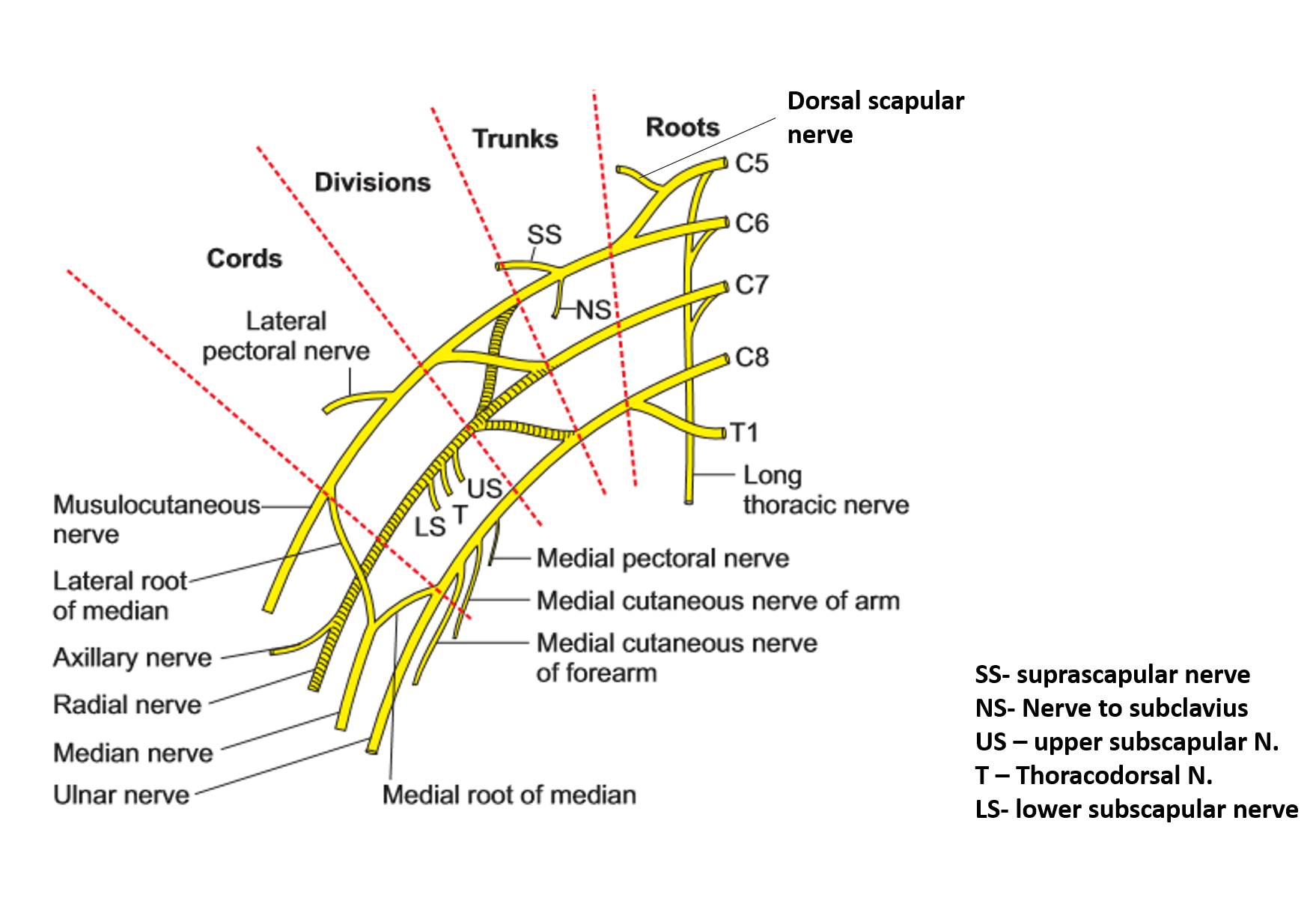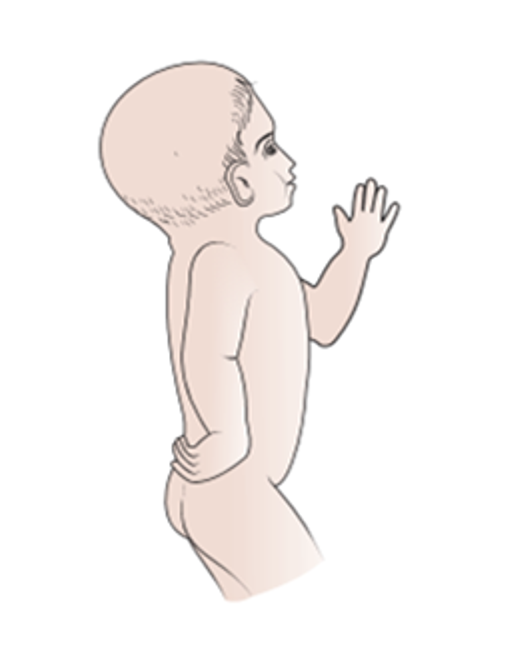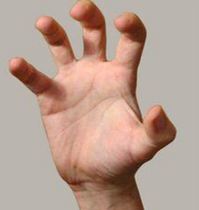Advertisements
Describe Formation and Parts of brachial plexus.
Formation : Brachial plexus is formed by the ventral rami of C5- C8 and T1 spinal nerves in the posterior triangle of the neck.
- Prefixed plexus : if there is contribution from C4 spinal nerve to the brachial plexus.
- Postfixed plexus : if there is contribution from T2 spinal nerve to the brachial plexus.
Course: Brachial plexus extends from the posterior triangle in the neck, through the cervico-axillary canal into the axilla.
Parts: Following are the parts of brachial plexus:
- Roots – Ventral/anterior rami of C5-C8 & T1 spinal nerves form the roots of brachial plexus.
- Trunks – The roots form three trunks:
- Upper trunk – C5 & C6 roots join to form upper trunk
- Middle trunk – C7 root forms middle trunk
- Lower trunk – C8 & T1 roots join to form lower trunk
- Divisions : Each trunk divides into anterior (ventral) and posterior (dorsal) divisions.
- Cords : Divisions form three cords
- Lateral cord – anterior divisions of upper and middle trunk join to form lateral cord.
- Medial cord – anterior division of lower trunk forms medial cord.
- Posterior cord – posterior divisions of all the three trunks join to form posterior cord.
Location of Brachial Plexus
Location: Brachial plexus is divided into two parts: supraclavicular and infraclavicular parts.
- Supraclavicular Part lies in the posterior triangle of neck. It comprises of roots and trunks of brachial plexus.
- Infraclavicular Part lies in the axilla. It comprises of cords of brachial plexus.
Enumerate the Branches of Brachial Plexus.
Branches of brachial plexus are:
From the roots:
- Dorsal scapular nerve (C5)
- Long thoracic nerve ( C5,C6,C7)
From the upper trunk:
- Suprascapular nerve ( C5, C6)
- Nerve to subclavius (C5,C6)
From the three cords of brachial plexus.
Branches of lateral cord – Three
- Lateral pectoral nerve ( C5-7)
- Lateral root of median nerve (C5-7)
- Musculocutaneous nerve (C5-7)
Branches of medial cord – Five
- Medial pectoral nerve (C8,T1)
- Medial cutaneous nerve of arm (C8,T1)
- Medial cutaneous nerve of forearm (C8,T1)
- Medial root of median nerve (C8,T1)
- Ulnar nerve (C8,T1)
Branches of posterior cord – Five
- Upper subscapular nerve (C5,C6)
- Lower subscapular nerve (C5,C6)
- Thoracodorsal nerve (C6-8)
- Axillary nerve (C5,C6)
- Radial nerve (C5-T1)

What is Erb’s Point?
Erb’s point is the region on upper trunk of brachial plexus where :
- There is union two roots – ventral rami of C5 & C6
- It divides into two divisions – anterior and posterior divisions
- It provides origin to two nerves – suprascapular and nerve to subclavius.

Applied Aspects
Erb’s paralysis (Erb-Duchenne Palsy)
- Site of lesion is Erb’s point i.e. upper trunk of brachial plexus(C5,C6).
- Cause is undue separation of head from the shoulder which may occur in the following conditions.
- An abnormal or difficult childbirth ( forceps delivery).
- When a person falls on shoulder.
- Position of the upper limb: It appears like a Policeman’s or Waiter taking tip.
- The arm is adducted and medially rotated.
- The forearm is extended and pronated.
- Motor loss :The muscles paralyzed are supraspinatus,deltoid,infraspinatus,teres minor biceps brachii, brachialis, brachioradialis and supinator.
- paralysis of supraspinatus and deltoid results in loss of abduction of arm.
- paralysis of infraspinatus and teres minor results in loss of lateral rotation of arm.
- paralysis of biceps brachii, brachialis, brachioradialis results in loss of flexion of forearm.
- paralysis of biceps brachii and supinator results in loss of supination of forearm.
- Sensory loss :There is loss of sensations from the skin over the lower part of the deltoid (supplied by axillary nerve -root value C5,C6).

Klumpke’s paralysis
- Site of lesion is lower trunk of brachial plexus (C8,T1).
- Cause is undue separation of arm from the trunk (abduction injury) which may occur in the following conditions.
- Birth injury
- Clutching something while falling from the height.
- Position of the hand is complete claw hand i.e.
- hyperextension at metacarpophalangeal joints
- flexion at interphalangeal joints.
- Motor loss: Intrinsic muscles of the hand are paralyzed.
- Sensory loss: Loss of sensations from a narrow zone along the medial side of hand and forearm.
- Horner’s syndrome : occurs due to involvement of sympathetic fibers of T1 spinal nerve.
- Characteristic features of Horner syndrome are:
- Partial Ptosis – drooping of eyelid (due to paralysis of a part of levator palpabrae superioris that is supplied by sympathetic fibers).
- Miosis – constriction of pupil (due to paralysis of dilator pupillae that is supplied by sympathetic fibers).
- Anhidrosis – decreased sweating.
- Enophthalmos – posterior displacement of the eye.


Mam your site is really helpfull. Thank you so much for always making our topics easy to understand.
THANK YOU
One of the best site on Google that i have found thank you so much mam
Such a useful knowledge